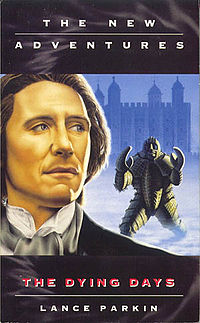Doctor Who: Sleepy
By Kate Orman / Virgin /March 1996
‘Stay the hell out of my mind,’ hissed Forrester. ‘Just stay away from me.’ She turned and stalked out of the room. Chris put his head in his hands.
The Earth colony on Yemaya 4 is a very ordinary place. The colonists spend their time farming, building homes, raising families.
But when the Doctor and his companions arrive they find a virus sweeping through the population, unleashing the colonists’ latent psychic powers. The Doctor and Chris fall prey to the infection, and discover telepathy is not the only symptom. Chris is unable to resist the call of an ancient place of sacrifice, while Roz and Benny travel back in time to the origin of the virus, and uncover a desperate bid for immortality.
And all the while the Doctor is playing a dangerous game with troopers of the Dione-Kisumu company, who have come either to reclaim the stolen biotechnology — or to sterilize the planet.
Kate Orman is still the only New Adventures author who is not male and not British. Whether or not it makes her a great writer, I can’t say, but Sleepy was an enjoyable read, perhaps because it had a simpler plot than her previous Who novels, The Left-Handed Hummingbird and Set Piece (which I heartily recommend).
The Doctor and his companions arrive on an Earth colony where the colonists are coping with the emergence of latent psychic abilities. For once, the Doctor knows little in advance about what’s going on, but is committed to helping the colonists. He and Chris fall prey to the virus unleashing the colonists’ psychic abilities, while Benny and Roz go back in time to find answers.
The situation is further complicated by the arrival of armed forces sent by the company that sponsored the colonization, and may have in fact planned the disaster as an experiment.
So far, this doesn’t seem like the most original plot line, but Orman throws in enough twists to make it a worthwhile read while also writing the Doctor and his companions the way they should be written.
Benny has got to be the greatest companion to date, despite the fact she’s never appeared on-screen. Roz and Chris don’t have major roles in the story, but at the same time it doesn’t seem as if they were plugged into the novel as an afterthought. Some fans have complained the Doctor has become a very dark, manipulative character in The New Adventures, but Orman keeps him balanced, throwing in humor reminiscent of the television series, but giving him depth by keeping him the most reflective, pensive Doctor to date.
All in all, Sleepy is one of the best New Adventures for 1996, and Orman fans won’t be disappointed.
 Doctor Who: The Dying Days
Doctor Who: The Dying Days